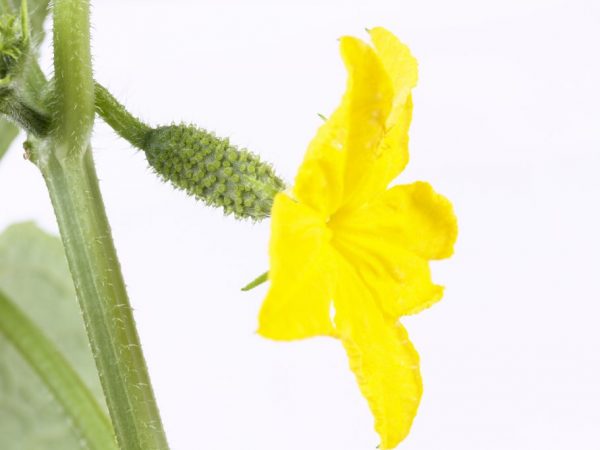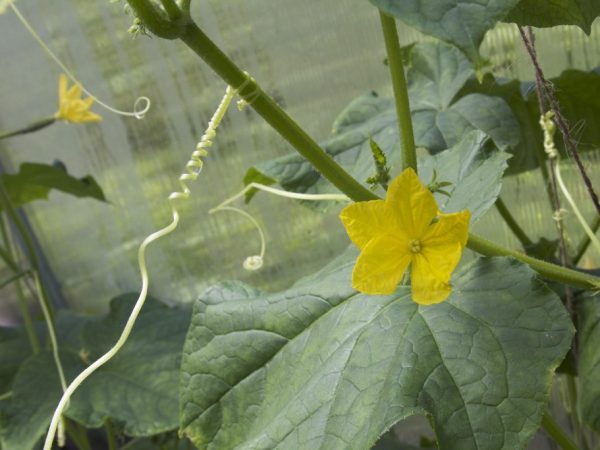Description of the flowering of female and male cucumbers
The flowering of cucumbers occurs in several ways: female, male and hermaphrodite. Yield depends on flowering, so you need to distinguish between flowering types.

Description of the flowering of female and male cucumbers
Female flowering type
Please note that the female-type cucumber flowers are characterized by an ovary, or rather a small cucumber. In this they differ from the male type even before the onset of the flowering period. Parthenocarpic form a green ovary, without signs of pollination. It's safe to say that this type of bloom doesn't need the help of bees or other pollinated insects.
In order for bee-pollinated cucumbers to form ovaries and form a fruit, pollination with peasant-type pollen must be performed. There are the following points of flower formation:
- long-fruited hybrids are characterized by the fact that no more than 2 female-type flowers can form in one node;
- bunch cucumbers can form about 10 ladies' flowers in 1 node.
Causes of developmental disorders
Quite often you can observe a situation when ladies' flowers develop longer than male ones. There are several reasons for this.
- These are the characteristics of the variety. Most of the varieties of cucumbers initially form a male flower, located on the main stem, and only then on the lateral shoots, a female species. This threatens that fertilization will be delayed indefinitely and the harvest will have to be harvested much later.
- The reason lies in the seed quality. Young seeds always form a maiden type first and only then a masculine one. If the seeds are characterized by an age of about 2 years, then the formation of flowering of both sexes occurs simultaneously. This allows you to speed up the process of fetal formation.
Male flowering type
The stamen type of flowering is characterized by the fact that it does not contain ovaries. The description of their appearance indicates that the flowers are characterized by a yellow color and are on a long pedicel. If we consider male flowers from the point of view of the biological component, then their main purpose is the pollination of female-type flowers, after which the formation of the fetus begins. Pollination is necessary so that fruits can form. This means that the crop will ripen in a short time.
Parthenocarpic cucumber grows without pollination. But, in this case, they completely lack seeds. In order to be able to collect seeds, parthenocarpic inflorescences must be constantly pollinated with male-type pollen.
The description indicates that male inflorescences most often begin to form on the main stem or lateral shoots. It is believed that most of this formation occurs in bundles. The pollen of the male inflorescence is rather heavy. Despite this, it does not fall out of the main flower, because the stickiness characteristic very strongly holds it in its place.For this reason, the wind cannot carry pollen, and pollination is only possible with the help of bees or other insects.
Hermaphrodite type of flowering

Cucumber flower can be male and female
The hermaphroditic species is the male and female cucumber flowers in one inflorescence. It is characterized by short ovaries. From such an ovary, most often, cucumbers appear, presented in a spherical shape. The description indicates that the hermaphrodite contains both pistils and stamens. Such inflorescences can be either self-pollinated or pollinated by insects. Same-sex flowers can be my characteristics.
- Andromonocial type. It includes bisexual features, where the male type predominates.
- Gynomonocy type. It is characterized by the fact that it contains hermaphroditic tendencies, in most of the female structure.
The main feature of this type is that its flowers are bisexual. Some experts confidently convince farmers that the first varieties of cucumbers were hermaphrodites. It was from them that the division into female and male types of flowering began. Most people try not to use this type of plant for sale. Such plants have gained great popularity only among breeders who are trying to create new varieties of cucumbers.
What flowers look like
The male inflorescence has cups, stamens and a corolla. If you are wondering how many stamens this species contains, then there are only 5. On each of them there is an anther, in which the pollen is stored.
Female inflorescences have a pistil. They do not possess stamens. The pistil consists of several main parts: ovary, pillar and stigma. The lower part usually has 3 slots.
Pollination process
The formula for the pollination process is simple. The pollen must get into the eggs, which are located in the ovules. After that, little time passes before the ovaries begin to form. The parthenocarpic species can form ovaries without pollination.
The pollen is ideal for pollination only before lunchtime. After this period, she begins to lose her vitality. If the color of the female inflorescence has a rich color, it means that it is completely ready for pollination. If the process has not occurred, then after a few days the color becomes paler.
Conclusion
After describing all the features, it is clear that the type of flowering determines not only the appearance of the bush, but also the time for which the fruit ripens. As the experience of many specialists shows, it is necessary to give preference to parthenocarpic female plants, because in this case it is possible to harvest much earlier.


